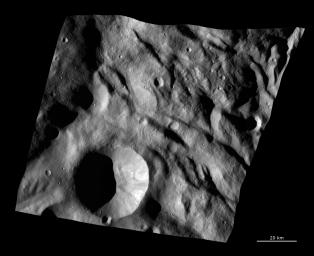Complex Surface Texture in Vesta’s Southern Hemisphere
Caption:
This Dawn FC (framing camera) image shows the texture of the surface in a part of Vesta's southern hemisphere. This region is just north of the main Rheasilvia structure. This image is dominated by the hummocky (i.e., wavy or undulating) terrain of Vesta's southern hemisphere, which is seen here as sets of large, arcuate (i.e., curved) ridges and depressions. These ridges and depressions run nearly horizontally across the image. There is another set of small grooves that run diagonally across this image. They seem to be cutting into, and are therefore younger than, the ridges and depressions. These grooves appear to form complex networks and are less than 500 meters (1,600 feet) wide on average. There is also a large crater in the bottom of this image, which has a sharp, fresh rim and slumping features along its rim and sides. However, this image does not contain many craters, which is not unexpected as it is located in Vesta's less heavily cratered southern hemisphere.
This image is centered in Vesta's Pinaria quadrangle and the center of the image is 63.2 degrees south latitude, 77.0 degrees east longitude. NASA's Dawn spacecraft obtained this image with its framing camera on Aug. 29, 2011. This image was taken through the camera's clear filter. The distance to the surface of Vesta is 2,740 kilometers (1,700 miles) and the image has a resolution of about 250 meters (820 feet) per pixel. This image was acquired during the survey phase of the mission.
Background Info:
The Dawn mission to Vesta and Ceres is managed by NASA's Jet Propulsion Laboratory, a division of the California Institute of Technology in Pasadena, for NASA's Science Mission Directorate, Washington. UCLA is responsible for overall Dawn mission science. The Dawn framing cameras have been developed and built under the leadership of the Max Planck Institute for Solar System Research, Katlenburg-Lindau, Germany, with significant contributions by DLR German Aerospace Center, Institute of Planetary Research, Berlin, and in coordination with the Institute of Computer and Communication Network Engineering, Braunschweig. The framing camera project is funded by the Max Planck Society, DLR, and NASA/JPL.
More information about the Dawn mission is online at
http://www.nasa.gov/dawn
and
http://dawn.jpl.nasa.gov
.
Cataloging Keywords:
| Name |
Value |
Additional Values |
| Target |
4 Vesta |
|
| System |
Main Belt |
|
| Target Type |
Asteroid |
|
| Mission |
Dawn |
|
| Instrument Host |
Dawn |
|
| Host Type |
Orbiter |
|
| Instrument |
Framing Camera (FC) |
|
| Detector |
|
|
| Extra Keywords |
Crater, Grayscale |
| Acquisition Date |
|
| Release Date |
2012-01-27 |
| Date in Caption |
2011-08-29 |
|
| Image Credit |
NASA/JPL-Caltech/UCLA/MPS/DLR/IDA |
| Source |
photojournal.jpl.nasa.gov/catalog/PIA15324 |
| Identifier |
PIA15324 |

 Planetary Data System
Planetary Data System
